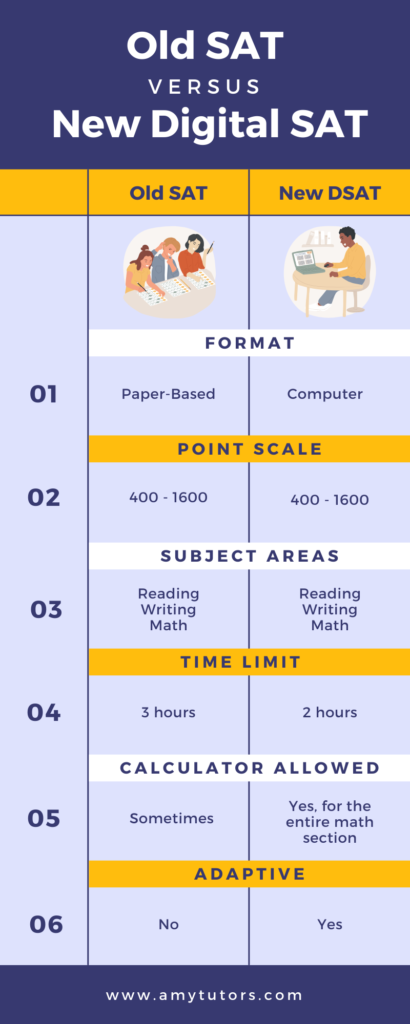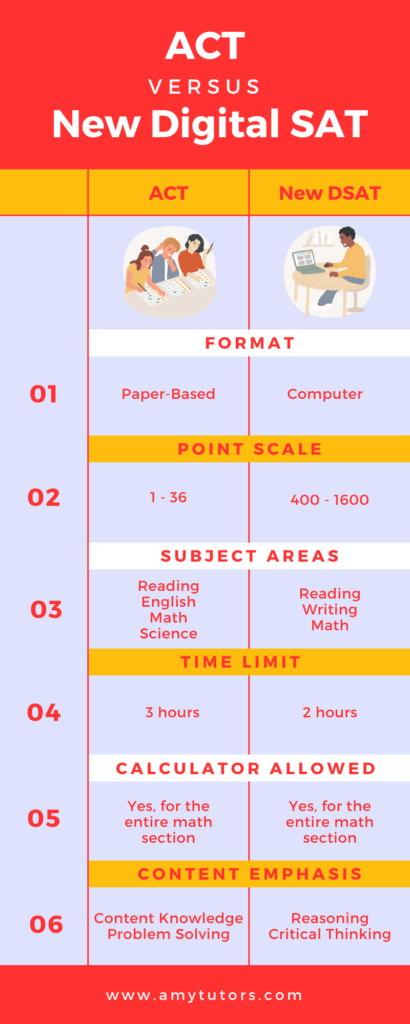Overview
The SAT has been used as a standardized measure of students’ readiness for higher education for nearly a century. The test has survived through several chances and iterations throughout the years in an attempt to keep up with the evolving landscape of education and technology. In Spring 2024, the College Board will implement it’s latest significant change: the Digital SAT. Let’s explore everything you need to know about the new Digital SAT, including its format, benefits, challenges, and implications for students.
Why the transition to digital?
The Digital SAT represents a shift from the traditional paper-based format to a computer-based test delivery system. This transition reflects broader trends in education towards digital learning methods. With the Digital SAT, students will complete the exam on computers or tablets, rather than using pencil and paper.
What kind of content is on the DSAT?
The format and content of the Digital SAT is still similar to the traditional exam. The DSAT will cover Reading, Writing, and Math, along with an optional Essay section. However, the DSAT will only contain two sections, one section titled Reading and Writing and a second section titled Math. It’s predecessor contained separate sections for Reading and Writing, respectively. The presentation of questions and the overall test-taking experience will be adapted for digital delivery as well. This includes interactive features such as highlighting, flagging questions, and digital scratch paper.
Is the change to the DSAT beneficial for students?
There are several benefits related to switching to a digital format. First, DSAT offers greater accessibility for students with disabilities, providing accommodations such as screen readers, magnification tools, and adjustable font sizes. Also, unlike the paper-based SAT, which requires manual scoring and several weeks for results, the DSAT offers instant scoring, providing students with immediate feedback on their performance. Finally, digital testing reduces the risk of cheating due to the answer choices being randomized and the transmission of test materials occurring electronically.
Are there any downsides?
Few things are perfect and the DSAT is no exception. There are a few issues with the new format. For example, the transition to digital testing raises concerns about access to technology and internet connectivity, particularly for students from underserved communities or rural areas. Additionally, students may require support and resources to adapt to the digital format and gain the skills to successfully navigate computer interfaces. Also, test anxiety is already a common concern with the paper-based SAT. Some students may experience heightened test anxiety or discomfort with digital testing, which could negatively impact their performance.
How should students prepare for the DSAT?
In addition to learning the foundational knowledge needed to answer reading, writing, and math questions, students should also familiarize themselves with digital tools. Take advantage of practice resources and tutorials provided by the College Board to become comfortable with the digital testing interface and features. Once students are comfortable with the basics, they should practice completing sections of the DSAT under timed conditions. That will help them improve their pacing and comfort level. In a more general sense, students can improve their digital literacy skills by engaging in online learning activities, using educational apps and resources, and practicing with digital study materials.
ACT vs New DSAT
How does the DSAT compare to the ACT?
Every year, some of my students ask me if they should focus on preparing for the SAT or the ACT. There is never a simple answer. There are pros and cons related to either option so it’s important to choose the test that aligns with the student’s strengths. Now, students should consider if they are more comfortable testing on a computer or tablet (the DSAT) or it they’d prefer to have a paper-based option (ACT). There is also a digital version of the ACT available in some locations.
What are the sections and timing constraints of each exam?
The DSAT consists of Reading and Writing and Math sections, with an optional Essay section. Without the essay, the test takes approximately 2 hours.
- Reading and Writing: 64-minute section with 54 questions (1 minute 11 seconds per question)
- Math: 70-minute section with 44 questions (1 minute 35 seconds per question)
The ACT includes English, Math, Reading, Science, and an optional Writing section.The ACT typically takes around 2 hours and 55 minutes without the writing section.
- English: 45-minute section with 75 questions (36 seconds per question)
- Math: 60-minute section with 60 questions (1 minute per question)
- Reading: 35-minute section with 40 questions (53 seconds per question)
- Science: 35-minute section with 40 questions (53 seconds per question)
As shown above, the time constraints are a little more lenient on the DSAT compared to the ACT. In fact, the DSAT offers an average of 68% more time per question than the ACT allows.
What kind of questions are on each exam?
The DSAT features a mix of multiple-choice, grid-in, and extended-thinking questions. The Reading and Writing section covers four main content domains—Craft and Structure, Information and Ideas, Standard English Conventions, and Expression of Ideas. Questions that test similar skills are grouped together. The Math section also focuses on four content areas —Algebra, Advanced Math, Problem-Solving and Data Analysis, and Geometry and Trigonometry. Overall, the SAT places more emphasis on vocabulary, reasoning, and critical thinking skills.
The ACT primarily consists of multiple-choice questions, with a science section that includes data interpretation and analysis. The English section tests the student’s mastery of Grammar, Punctuation, Sentence Structure and Rhetorical Skills. The Math section focuses on Algebra I and II, Geometry, and some Trigonometry. The Reading section has 4 types of passages — Prose Fiction, Social Studies, Humanities, and Natural Sciences. The Science section includes questions about science-based passages. In general, the ACT tends to focus more on content knowledge and straightforward problem-solving.
FUN FACT! The SAT is more commonly taken on the East and West coasts of the United States, while the ACT is more popular in the Midwest and Southern regions, though both tests are widely accepted by colleges and universities across the country.
NEW DSAT and the Bright Futures Scholarship
For Florida students, the SAT and ACT fulfill essential criteria for the Bright Futures Scholarship Program. There are two levels of scholarships. Florida Academic Scholars is the more competitive option out of the two. Recipients are awarded 100% of their tuition and fees for up to 5 years. The other level is the Florida Medallion Scholars. This option is easier to qualify for, but recipients are only awarded 75% of their tuition and fees.

Now, you’re up to speed on the details about the New Digital SAT! Hopefully, this article will help you make an informed decision about taking the DSAT and feel more prepared for it when you do.
Happy studying!




